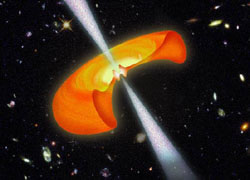
Artist's rendition of a gamma-ray burst. Credit: NASA - click to enlarge.
European Space Agency -- For a few seconds every day, Earth is bombarded by gamma rays created by cataclysmic explosions in distant galaxies. Such explosions, similar to supernovae, are known as ‘gamma-ray bursts’ or GRBs.
Astronomers using ESA’s X-ray observatory, XMM-Newton, are trying to understand the cause of these extraordinary explosions from the X-rays given out for a day or two after the initial burst.
However, the violence of the process begs the question, what happens to the space surrounding a GRB? A few years ago, some astronomers thought that a GRB might wipe out all life in its host galaxy.
That now seems to be a pessimistic view because the latest evidence shows that GRBs focus their energy along two narrow beams, like a lighthouse might do on Earth, rather than exploding in all directions like a bomb.
That does not mean that GRBs are not dangerous. Some theories suggest that anything caught in the beam, out to a distance of around 200 light years, will be vaporised.
Which should take care of all the rich people. And the rest of us. Ah, well. Maybe the roaches will do a better job.

Comments